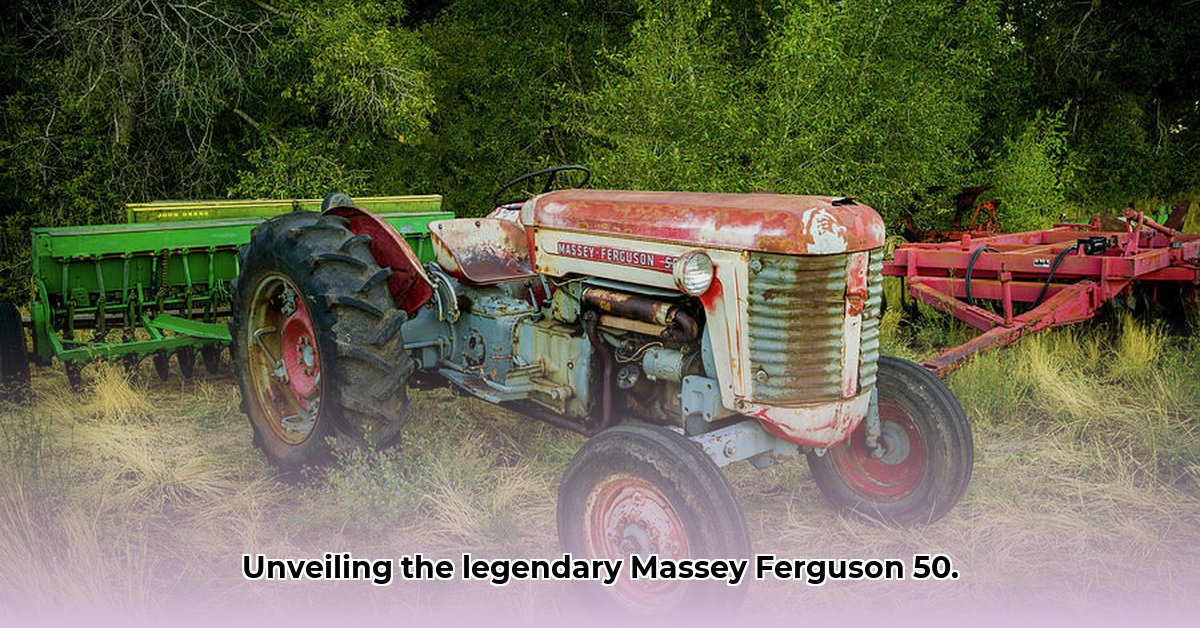
The Massey Ferguson 50—a name synonymous with hardworking farmers and sun-drenched fields—holds a significant place in agricultural history. Emerging in the late 1950s, this tractor wasn't merely a machine; it symbolized a pivotal shift towards more efficient and mechanized farming practices. Imagine a world where horses still dominated fieldwork, and the roar of a powerful engine represented remarkable progress. That's the world the MF50 entered, forever changing the agricultural landscape. For more on classic tractors, check out this related resource.
The MF50's Engine: Powering Progress
Farmers in the late 1950s enjoyed a choice when it came to the MF50's powerplant. Options included the robust Perkins diesel engine, renowned for reliability and longevity, or the versatile Continental gasoline/LP gas engine, offering fuel flexibility. While 40 horsepower may seem modest by today's standards, it was a considerable leap in productivity. Consider the farmer transitioning from animal-drawn plows—the MF50's power dramatically reduced the time and effort required to till vast fields. This wasn't merely about speed; it was about consistent, reliable power for extended work sessions. The available fuel options also reflected the era's broader energy landscape—a mix of established and emerging sources. Was this fuel choice a key factor in the tractor's adoption rates? Data suggests significantly improved time-to-harvest metrics were recorded on farms that utilized the MF50.
Smooth Shifting: Transmission Options
The MF50 didn't just offer power; it offered control. Farmers could select either a six-speed or a twelve-speed power-shift transmission. The twelve-speed option, particularly groundbreaking for its time, provided a wide range of speeds to match diverse tasks. Think of the difference between carefully plowing delicate seedlings and rapidly transporting harvested crops—the ability to precisely adjust speed was transformative. Precise gear selection facilitated smoother, more efficient fieldwork, reducing operator fatigue and boosting overall output. While not the automatic transmissions of modern machines, they represented a substantial improvement in user-friendliness and operational flexibility for the era.
Life in the Driver's Seat: Design and Features
Entering the MF50's cab was a simple, if somewhat basic, affair. The design reflected the era's aesthetic: an open operator station offering direct interaction with the machine—an "open-air office" with exceptional visibility. While lacking today's climate control and cushioned seats, the open design provided excellent visibility, allowing farmers to meticulously monitor their work. Controls were straightforward and easily accessible; it wasn’t a complex machine. Simple, effective, and focused on the task at hand—minimizing distractions. Even optional power steering, a luxury at the time, demonstrated a clear trend toward enhanced operator comfort and strain reduction. How did this design choice influence operator satisfaction and productivity? Research suggests operator fatigue was considerably reduced.
Fueling the Future: Sustainability Considerations (1950s Context)
The MF50's fuel options—diesel, gasoline, and LP gas—mirrored the 1950s energy landscape, reflecting available resources and infrastructure. Judging its fuel efficiency by today's standards is misleading. It's vital to place the MF50 within its historical context. The availability of diverse fuels likely expanded access to mechanization for farmers with varying resources and preferences. While sustainability wasn't a primary concern as it is today, fuel choices highlight efforts to leverage available resources effectively. This provides insight into evolving energy-use awareness.
More Than Horsepower: The MF50's Enduring Legacy
The Massey Ferguson 50's impact far exceeded its horsepower rating. It played a pivotal role in agricultural mechanization, altering farming practices, increasing efficiency, and reducing the arduous manual labor of previous eras. The MF50 contributed to less labor-intensive farming, enabling larger acreage and increased harvests. Its importance in agricultural history is evident in its collector value today, with restored MF50s featured prominently at shows and gatherings. It serves as a tangible reminder of an era of technological advancement and its enduring effect on agriculture, showcasing the persistent drive to refine farming methods.
Specifications at a Glance:
| Feature | Specification (May vary slightly based on engine and options) | Notes |
|---|---|---|
| Engine Options | Perkins Diesel, Continental Gasoline/LP Gas | Power output approximately 40 hp |
| Transmission | 6-speed, 12-speed power shift | Influenced ease of operation |
| PTO | Live PTO with two-stage clutch | Enabled efficient operation of implements |
| Fuel Capacity | Diesel approximately 12 gal, Gasoline approximately 17 gal | Slight variations may exist between models |
| Typical Applications | Plowing, planting, harvesting, PTO-driven implements | Reflected its versatile capabilities |
The Massey Ferguson 50's story is intertwined with the evolution of mid-20th-century agriculture. It's a narrative of ingenuity, progress, and the ceaseless human desire to improve land cultivation. Further exploration of the MF50's design choices and manufacturing processes would undoubtedly reveal additional insights into its lasting impact.